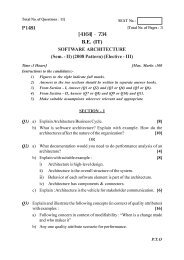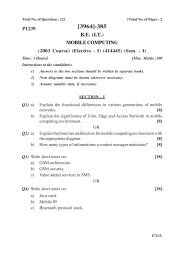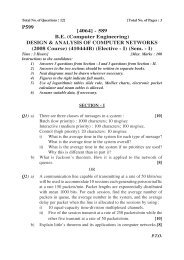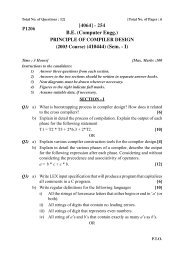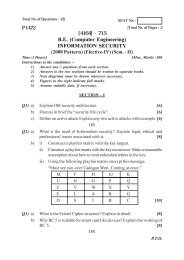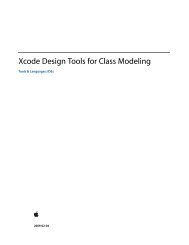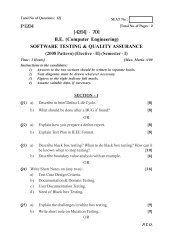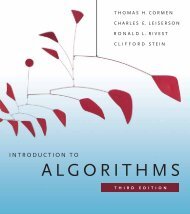Cloud Computing and SOA Convergence in Your Enterprise: A Step ...
Cloud Computing and SOA Convergence in Your Enterprise: A Step ...
Cloud Computing and SOA Convergence in Your Enterprise: A Step ...
Create successful ePaper yourself
Turn your PDF publications into a flip-book with our unique Google optimized e-Paper software.
90 Chapter 5 Work<strong>in</strong>g from <strong>Your</strong> Data to the <strong>Cloud</strong>s<br />
You Can Skip Ontologies<br />
While us<strong>in</strong>g ontologies is very helpful when deal<strong>in</strong>g with complex problem doma<strong>in</strong>s<br />
with complex data, the use of ontologies as an approach to generaliz<strong>in</strong>g<br />
<strong>and</strong> underst<strong>and</strong><strong>in</strong>g data with<strong>in</strong> a problem doma<strong>in</strong> is optional. Many architects<br />
delve right <strong>in</strong>to the data analysis, skipp<strong>in</strong>g ontologies, <strong>and</strong> that is perfectly<br />
okay. We present ontologies here as an approach to analyz<strong>in</strong>g data that can<br />
prove to be very productive.<br />
Us<strong>in</strong>g ontologies as a start<strong>in</strong>g po<strong>in</strong>t makes the more detailed analysis<br />
that much easier to deal with because we have already def<strong>in</strong>ed the general<br />
categories. From there, we can work down to the details of the metadata. We<br />
want to def<strong>in</strong>e the <strong>in</strong>formation with<strong>in</strong> our problem doma<strong>in</strong> more holistically<br />
before def<strong>in</strong><strong>in</strong>g it <strong>in</strong> more detail. Ontological analysis clears the ground for<br />
generalization, mak<strong>in</strong>g the properties of the entities much clearer. Ontological<br />
analysis for <strong>SOA</strong> us<strong>in</strong>g cloud comput<strong>in</strong>g encourages generalization.<br />
One of the benefits of leverag<strong>in</strong>g ontologies is that no matter where the<br />
<strong>in</strong>formation resides, we can underst<strong>and</strong> <strong>and</strong> map <strong>in</strong>formation relevant to our<br />
<strong>SOA</strong> us<strong>in</strong>g cloud comput<strong>in</strong>g. Ontologies allow us to differentiate between resources,<br />
which is especially useful when those resources have redundant data<br />
(e.g., customer <strong>in</strong>formation <strong>in</strong> almost all enterprises). By mak<strong>in</strong>g better sense<br />
of the data <strong>and</strong> represent<strong>in</strong>g the data <strong>in</strong> a mean<strong>in</strong>gful way, terms def<strong>in</strong>ed <strong>in</strong><br />
ontologies allow the architect to fully underst<strong>and</strong> the mean<strong>in</strong>g <strong>and</strong> context of<br />
the <strong>in</strong>formation.<br />
An important notion of ontologies is entity correspondence. Ontologies<br />
that are leveraged <strong>in</strong> more of a distributed environment, such as bus<strong>in</strong>ess-tobus<strong>in</strong>ess<br />
or cloud comput<strong>in</strong>g, must leverage data that is scattered across very<br />
different <strong>in</strong>formation systems <strong>and</strong> <strong>in</strong>formation that resides <strong>in</strong> many separate<br />
doma<strong>in</strong>s. Ontologies, <strong>in</strong> this scenario, provide a great deal of value because<br />
we can jo<strong>in</strong> <strong>in</strong>formation together, such as product <strong>in</strong>formation mapped to<br />
on-time delivery history, mapped to customer compla<strong>in</strong>ts <strong>and</strong> compliments.<br />
This establishes entity correspondence between data that is physically distributed,<br />
such as on-premise or with<strong>in</strong> clouds.<br />
To gather <strong>in</strong>formation specific to an entity, we need to leverage different<br />
resources to identify <strong>in</strong>dividual entities, which vary widely from each physical<br />
<strong>in</strong>formation store. For example, when leverag<strong>in</strong>g a relational database,<br />
entities are identified us<strong>in</strong>g keys (e.g., customer numbers). With<strong>in</strong> the vari-



